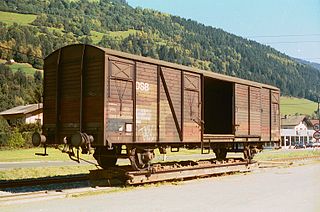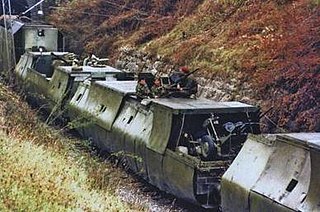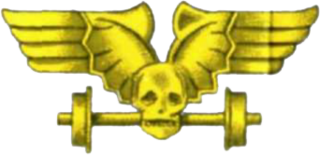
A bogie is a chassis or framework that carries a wheelset, attached to a vehicle—a modular subassembly of wheels and axles. Bogies take various forms in various modes of transport. A bogie may remain normally attached or be quickly detachable. It may include a suspension component within it, or be solid and in turn be suspended ; it may be mounted on a swivel, as traditionally on a railway carriage or locomotive, additionally jointed and sprung, or held in place by other means.

A railroad car, railcar, railway wagon, railway carriage, railway truck, railwagon, railcarriage or railtruck, also called a train car, train wagon, train carriage or train truck, is a vehicle used for the carrying of cargo or passengers on a rail transport network. Such cars, when coupled together and hauled by one or more locomotives, form a train. Alternatively, some passenger cars are self-propelled in which case they may be either single railcars or make up multiple units.

An armoured train or armored train is a railway train protected with heavy metal plating and which often includes railway wagons armed with artillery, machine guns, and autocannons. Some also had slits used to fire small arms from the inside of the train, especially in earlier armoured trains. For the most part, they were used during the late 19th and early 20th centuries, when they offered an innovative way to quickly move large amounts of firepower into a new location. Most countries discontinued their use – road vehicles became much more powerful and offered more flexibility, train tracks proved too vulnerable to sabotage and attacks from the air, and air transportation was an even more flexible way to relocate firepower to a new location. However, there were occasional uses in the late 20th century and early 21st century Russian Federation used improvised armoured trains in the Second Chechen War (1999–2009) and the Russian invasion of Ukraine (2022–present).

A transporter wagon, in railway terminology, is a wagon (UIC) or railroad car (US) designed to carry other railway equipment. Normally, it is used to transport equipment of a different rail gauge. In most cases, a transporter wagon is a narrower gauge wagon for transporting a wider gauge equipment, allowing freight in a wider gauge wagons to reach destinations on the narrower gauge network without the expense and time of transshipment into a narrower gauge wagons.

A railway gun, also called a railroad gun, is a large artillery piece, often surplus naval artillery, mounted on, transported by, and fired from a specially designed railway wagon. Many countries have built railway guns, but the best-known are the large Krupp-built pieces used by Germany in World War I and World War II. Smaller guns were often part of an armoured train. Only able to be moved where there were good tracks, which could be destroyed by artillery bombardment or airstrike, railway guns were phased out after World War II.

The Flak 30 and improved Flak 38 were 20 mm anti-aircraft guns used by various German forces throughout World War II. It was not only the primary German light anti-aircraft gun but by far the most numerously produced German artillery piece throughout the war. It was produced in a variety of models, notably the Flakvierling 38 which combined four Flak 38 autocannons onto a single carriage.

Bogie exchange is a system for operating railway wagons on two or more gauges to overcome difference in the track gauge. To perform a bogie exchange, a car is converted from one gauge to another by removing the bogies or trucks, and installing a new bogie with differently spaced wheels. It is generally limited to wagons and carriages, though the bogies on diesel locomotives can be exchanged if enough time is available.

The Krauss-Maffei ML 4000 is a road switcher diesel-hydraulic locomotive, built between 1961 and 1969 by German manufacturer Krauss-Maffei in Munich, Germany. It generated 3,540 horsepower (2,640 kW) from two Maybach V16 engines. 37 examples were built for two North American railroads and one South American railroad.

The Anoa is a 6x6 armoured personnel carrier developed by PT Pindad of Indonesia. The vehicle is named after the Anoa, which is a type of buffalo indigenous to Indonesia. The prototype was first unveiled at the 61st anniversary of TNI on October 5, 2006, in TNI HQ at Cilangkap, east of capital Jakarta.

Piłsudczyk was a Polish armoured train of the early 20th century. It was among the first armoured trains serving the Polish Army and took part in the Polish-Ukrainian War of 1918-1919, the subsequent Polish-Soviet War and the Silesian Uprisings. Kept in reserve during the inter-war years, it was mobilised again in 1939 to be used during the Nazi-Soviet Invasion of Poland. "Piłsudczyk" was destroyed by its crew on 20 September 1939 at the train station at Mrozy.
Armored trains of Poland mostly date to the World War I period. Many of them were modernized over the next two decades, and took part in most military conflicts of the Second Polish Republic, namely the Greater Poland Uprising, the Polish-Ukrainian War, the Polish-Bolshevik War, the Silesian Uprisings and the Polish September Campaign in World War II. Armored trains were also used by the Polish Armed Forces in the West as well as in the post-war period by the Polish Railroad Guards and the People's Army of Poland.

The Sumida M.2593 was an armoured car produced by the Empire of Japan in the 1930s. It could operate on both the roadway and railway lines. There were two main versions of the Sumida M.2593 made. The Type 91 armoured railroad car was used by the army and the Sumida Model P armored car was used by the Special Naval Landing Forces (SNLF) of the navy.

The Krajina Express was an improvised armored train used by the Krajina Serb army during the Croatian War of Independence and the Bosnian War, from 1991 to 1995.
The Russian armoured train Yenisei is an armoured train currently in use by the Russia in their ongoing invasion of Ukraine in 2022. According to Ukrainian sources, Yenisei was constructed out of parts stolen from Ukrainian Railways in the Kharkiv region.

The Armored Train Regiment was an armored regiment of the Estonian Defense Forces from 1934–1941. In 1939, the strength of the regiment was 544 men. The symbol of the regiment was a skull with wings on train wheels, symbolizing how armored trains fought in the Estonian Independence War. The symbol was nicknamed "Flying death on the railway".
The Russian armoured train Volga is an armoured train currently in use by Russia in its ongoing invasion of Ukraine in 2022. Unlike its sister train Yenisei, which is built primarily for logistics and refugee ferrying, Volga is primarily used for engineering, reconnaissance, mine clearance, restoration of damaged railway tracks, and escorting cargo within the Ukrainian combat zones.
The Russian armoured train Amur is an armoured train currently in use by Russia in its ongoing invasion of Ukraine in 2022. Unlike the trains, Yenisei and Volga, Amur was already built long before the Russian invasion of Ukraine. Both Amur and its sister train, Baikal was reactivated back in 2016, originally for rear-line logistical purposes.
The Russian armoured train Baikal is an armoured train currently in use by Russia in its ongoing invasion of Ukraine in 2022. Unlike the trains, Yenisei and Volga, Baikal was already built long before the Russian invasion of Ukraine. Both Baikal and its sister train, Amur was reactivated back in 2016, originally for rear-line logistical purposes.













